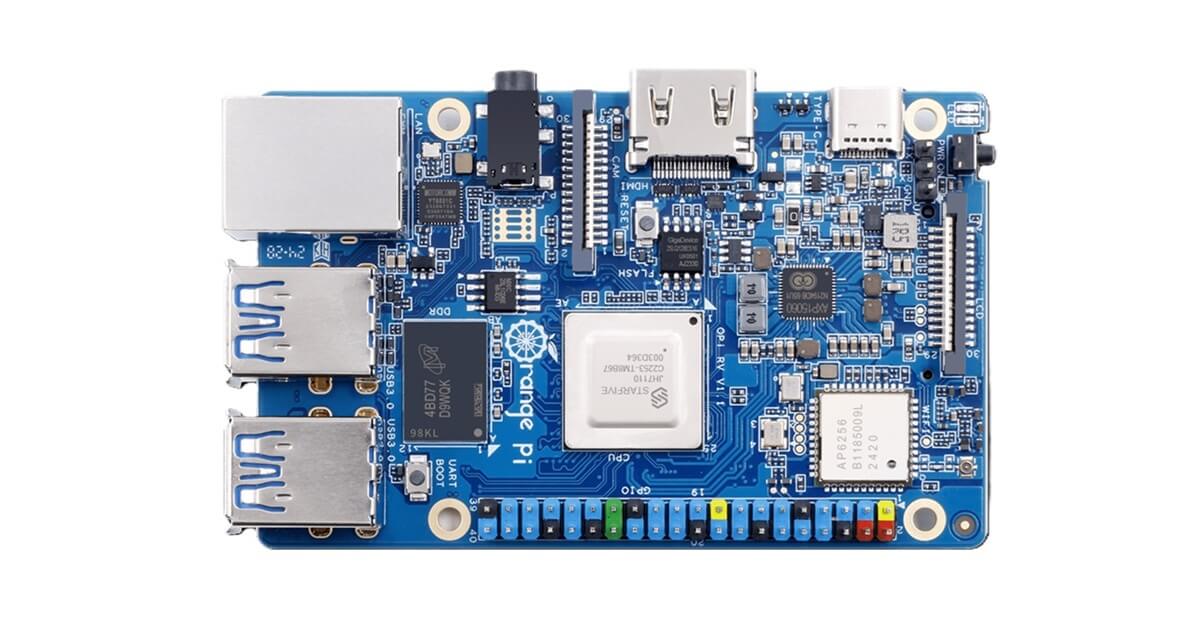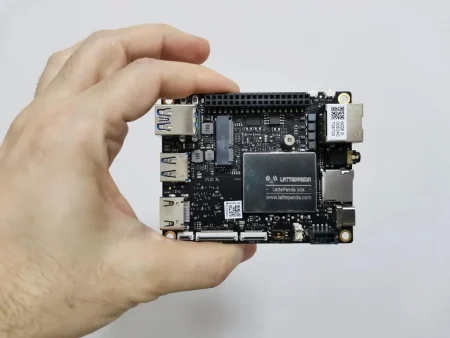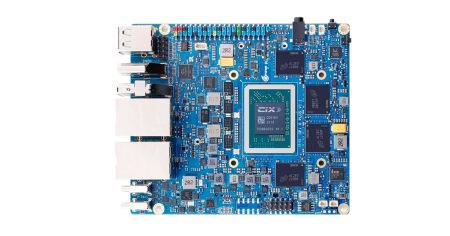- Maybe you missed it? Orange Pi RV2 Review
- Orange Pi RV Review, Specs, Features, Interfaces, and Price.
The RV is an energy-efficient, compact single-board computer, positioning it as an excellent choice for those seeking a budget-friendly option in the low- to mid-range category. Now, let’s dive into its advantages and drawbacks.
- Very low price point (Starting at $30.00).
- M.2 M-Key 2280 PCIe SSD slot.
- 1GbE port.
- Integrated Wi-Fi support.
- 3.5mm Headphone jack.
- HDMI 2.0 (up to 4K@30fps).
- 40-pin header interface.
- USB Ports: 4x USB 3.0.
- MIPI DSI / CSI Interfaces.
- No DDR5 RAM.
- No Wi-Fi 6 Support.
Shenzhen Xunlong has unveiled the Orange Pi RV, a cutting-edge single-board computer featuring a StarFive CPU built on RISC-V architecture.
The Orange Pi series, created by Shenzhen Xunlong Software Co., Ltd., consists of an array of single-board computers (SBCs) renowned for their compact design and robust performance. These versatile devices are perfect for a wide range of applications, including IoT initiatives, home automation, and educational projects. Their affordability and adaptability have made Orange Pi boards a favored choice for hobbyists, developers, and technology enthusiasts alike.
Part I: Introducing the Orange Pi RV
Following the surge of RISC-V single-board computers released by various Chinese manufacturers, the Orange Pi RV stands out as a highly compact board, surpassing both a credit card and the Raspberry Pi 5. Its portable design is perfect for various applications. Notably, this model represents a significant milestone in the evolution of single-board computers, as it is the newest member of the Orange Pi family. Utilizing RISC-V-based hardware at more accessible prices for both developers and mainstream consumers.
Key Takeaways
- Multiple RAM Configurations: 2GB/4GB/8GB LPDDR4.
- Gigabit Ethernet interface
- Interfaces: MIPI DSI, MIPI CSI, 40-Pin expansion port, 3.5mm headphone jack, Type-C 5V4A power supply, and so on.
- M.2 M-Key PCIe SSD card slot.
- 4x USB 3.0 host ports.
- HDMI Type A, 2.0, up to 4K@30fps.
- High performance combined with low power usage, compared to traditional SBCs.
Orange Pi RV Specifications
| CPU | JH-7110 |
| GPU | RISC-V architecture |
| RAM | 2 GB/4 GB/8 GB LPDDR4, 2800 MT/s Single-channel B200 balls |
| Memory | 1x M.2 NGFF PCIe (2280) 1x TF card slot, SDIO signal, max support 1 TB |
| Wi-Fi + BT | • Wi-Fi 5 + BT 5.0 • Wi-Fi Interface: SDIO 2.0, Model: AP6256 |
| Ethernet | Support 10/100/1000 Mbps *1 YT8531C |
| USB | USB 3.0 x4; PCIe to USB 3.0 hub |
| Camera | 2-Lane CSI*1, dual-row 30-Pin |
| Video | 1x HDMI Type A, 2.0, up to 4K@30fps • 2-Lane DSI*1, dual-row, 30-pin |
| Audio | 3.5 mm, 4-section headphone cradle, left and right channels only, no MIC |
| Expansion port | 40-pin expansion interface: UART serial port, I2C, 3V/5V power supply, and other GPIOs |
| Indicator light | Power on lamp |
| Power button | Side buttons, board edge |
| Reset button | Horizontal buttons, in-board |
| Burn flash button | Horizontal buttons, in-board (for burning from USB when the flash drive is damaged) |
| Power source | Type-C port power supply, rated 5V, 4A |
| Supported OS | Linux |
| Dimension | 89 × 56 × 1.6 mm |
| Weight | 54g |
Raspberry Pi 5 vs. Orange Pi RV
Here’s the specs detailed, comparing the Raspberry Pi 5 (8GB) and Orange Pi RV (8GB):
| Feature | Raspberry Pi 5 (8GB) | Orange Pi RV (8GB) |
|---|---|---|
| Processor | Broadcom BCM2712 2.4GHz quad-core ARM Cortex-A76 | StarFive JH7110 1.5GHz RISC-V quad-core |
| Graphics | VideoCore VII GPU (Up to 800MHz) | IMG BXE-4-32 MC1 (Up to 600MHz) |
| RAM | LPDDR4X-4267 SDRAM | 8GB LPDDR4/4x |
| microSD card slot | ✅ | ✅ |
| Dual-band 802.11ac Wi-Fi® w/ BT5.0 | ✅ | ✅ |
| 1GbE Ethernet | ✅ | ✅ |
| USB Host Ports | 2 × USB 2.0 ports 2x USB 3.0 ports | 4x USB 3.0 |
| Dual Display Output | ✅ | ❌ |
| HDMI Output | 4Kp60 | 4Kp30 |
| Camera Interfaces | 2 × 4-lane MIPI camera | 2 × 2-lane MIPI camera |
| Display Serial Interface (DSI) | ❌ | ✔ |
| AI Capabilities | ❌ | ❌ |
| Connectivity | USB 3.0, Ethernet, GPIO pins | USB 3.0, USB 2.0, Ethernet, GPIO pins |
| Expandability | SD card support, PCIe (via add-ons) | SD card, SATA, PCIe, M.2 NVMe (2280) slots and SPI Flash. |
| Power Efficiency | Moderate power efficiency | High power efficiency with better thermal management |
| Estimated Price (Excluding shipping) | $75 | $49.90 |
| Starting Price (2GB RAM Model) (Excluding shipping) | $50 | $30.00 |
| Community Support | Extensive community with robust documentation. | Growing community but less extensive than Raspberry Pi. |
Summary:
- Raspberry Pi 5: Great for general computing with strong community support but missing features like an integrated M.2 NVMe SSD Socket.
- Orange Pi RV: Provides enhanced possibilities for hardware upgrades, improved power efficiency, and is built on the open-source RISC-V architecture.
Comparing RISC-V with other SBCs available on the market.
When comparing the performance of RISC-V-based SBCs like the Orange Pi RISC-V with traditional architectures such as ARM or x86, several factors come into play. While ARM-based SBCs have dominated the market for years, RISC-V introduces a new paradigm that emphasizes openness and extensibility. In terms of raw processing power, RISC-V processors have demonstrated competitive performance in various benchmarks and real-world applications.

Inside the hardware: What you need to know.
The JH-7110 is a system-on-a-chip (SoC) designed and manufactured in China. It features a 1.5 GHz StarFive JH7110 processor with four RV64GC CPU cores based on the RISC-V architecture. The dimensions are 89 x 56 mm (3.5″ x 2.2″), and it supports up to 8 GB of memory along with various I/O capabilities. The company behind Orange Pi devices announced its development earlier this year, and the specifications are now available on the Orange Pi website.
Although the JH7110 processor may not be the quickest on the market, it offers a solid foundation for both developers and hobbyists to delve into the world of RISC-V chips. With several years of existence and an increasing number of boards from renowned companies such as Milk-V, Pine64, Geniatech, and Framework, the processor is well-supported and ready for exploration.
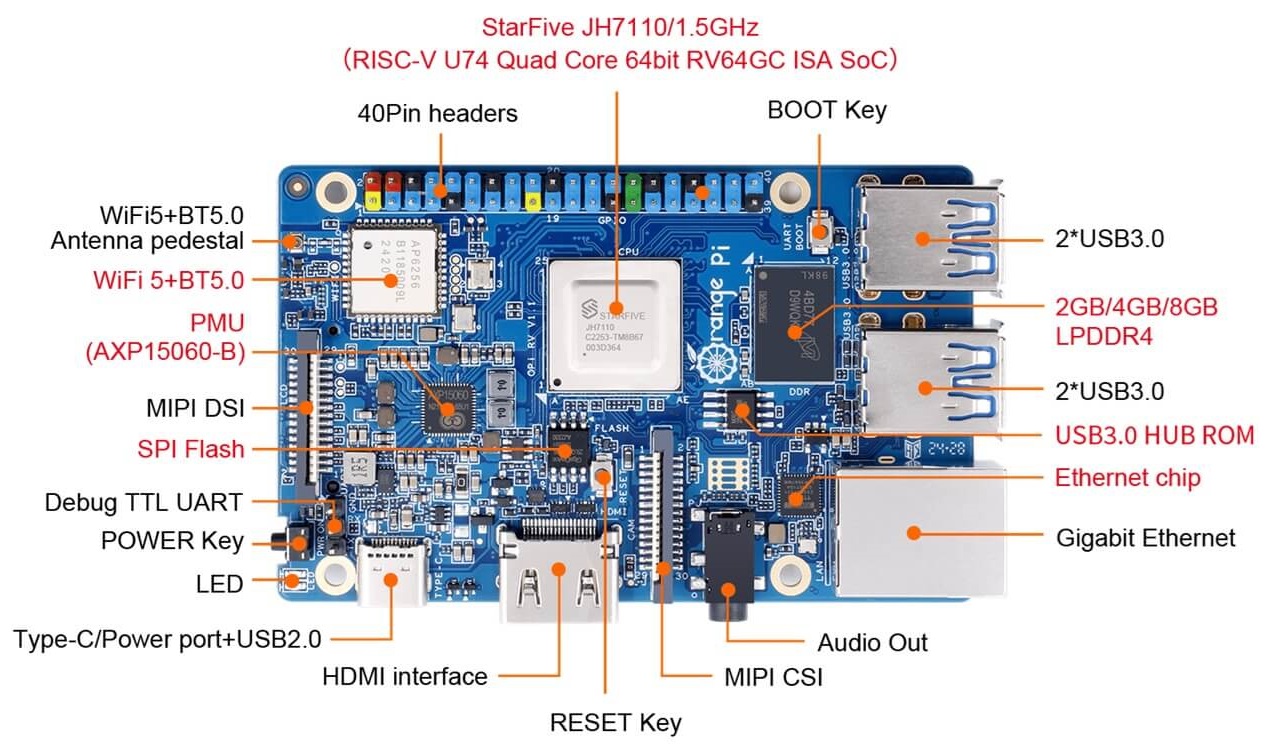
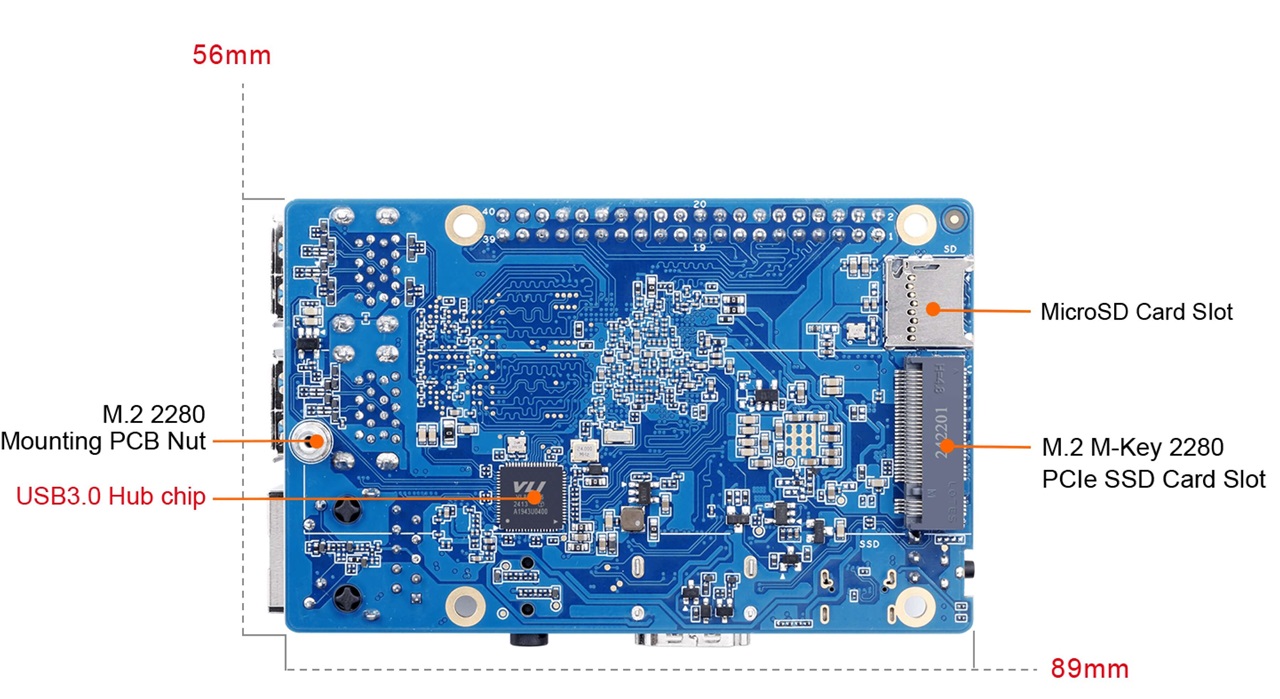
Software Support
The product page for the Orange Pi RV is currently undergoing updates. However, we anticipate that it will be compatible with all major Linux distributions, including Debian and Ubuntu, as well as Android. Furthermore, the official Orange Pi website provides download links for both official images and those from third-party partners.
Official Ubuntu Support
Canonical, known for its proficiency in open-source software and services, and recognized as the creator of Ubuntu, has started providing developer images for Orange Pi boards based on RISC-V architecture. (Media Source: Here).
Concluding Remarks
The Orange Pi RV boasts a powerful processor combined with a versatile board that offers options of 2GB, 4GB, or 8GB of LPDDR4-2800 single-channel memory. It includes a microSD card reader and an M.2 2280 slot for PCIe 2.0 SSD storage, making it an exceptionally budget-friendly choice for users seeking affordable hardware solutions.

